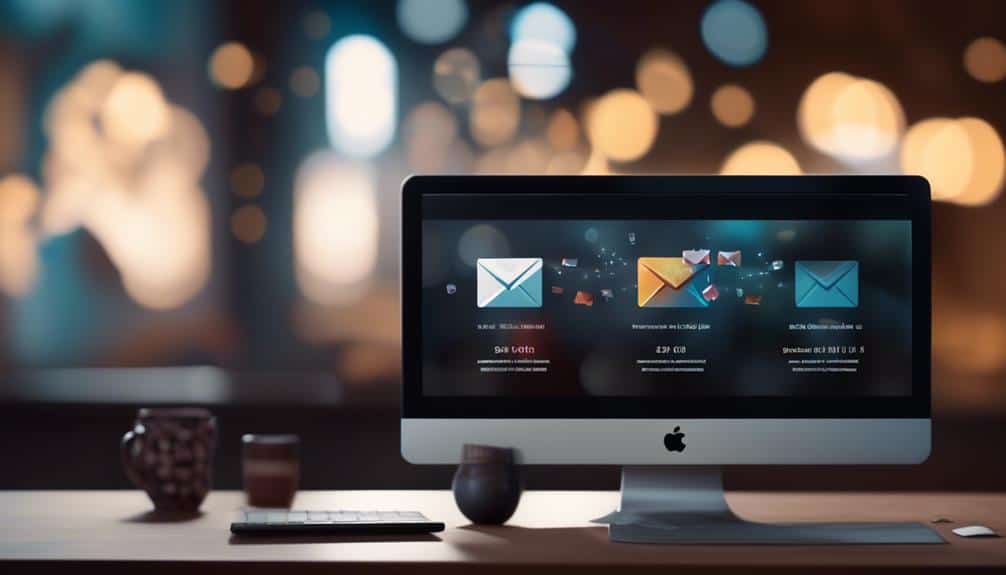Urgent: Uncover the Secrets of A/B Testing for Game-Changing Email Results
In the ever-evolving world of email marketing, staying ahead of the competition is key. You know the importance of sending impactful emails that drive results, but how do you truly unlock the secret to game-changing success?
Enter A/B testing. This powerful technique allows you to compare and contrast different elements of your emails, helping you uncover the hidden gems that can skyrocket your open rates, click-throughs, and conversions.
But don't worry, you don't have to be a marketing guru to master this art. With a few simple strategies and a keen eye for detail, you can harness the power of A/B testing to take your email campaigns to new heights.
So, are you ready to discover the secrets that will revolutionize your email marketing game?
Key Takeaways
- A/B testing in email marketing allows for scientific analysis and optimization of email campaigns.
- Choosing the right elements for A/B testing, such as subject lines, call-to-action prompts, and email layout and design, can significantly impact user engagement and conversion rates.
- Crafting compelling subject lines with personalization, urgency, curiosity, and clarity can boost open rates.
- Testing email copy with different tones and messaging, tailored to the target audience, and optimizing email design with effective color combinations can improve overall email marketing strategy and results.
Importance of A/B Testing in Email Marketing

A/B testing is an essential practice in email marketing that allows you to scientifically analyze and optimize your email campaigns for maximum effectiveness. By implementing this method, you can make informed decisions based on data and improve your overall email marketing strategy.
One of the key aspects of A/B testing is choosing effective test variables. This involves carefully selecting the elements you want to test in your email campaigns, such as subject lines, call-to-action buttons, or email content. By varying these variables and comparing the results, you can determine which elements resonate best with your audience and drive higher engagement and conversion rates.
To analyze test results accurately, it's crucial to establish clear goals and metrics for success. Define what you consider a successful outcome for each test, whether it's increased open rates, click-through rates, or conversions. Using an email marketing platform that provides detailed analytics and reporting capabilities can greatly simplify this process.
When analyzing test results, focus on statistical significance rather than relying solely on intuition. Look for patterns and trends in the data, and draw meaningful conclusions based on statistical significance. By doing so, you can ensure that your decisions are data-driven and have a higher likelihood of success.
Choosing the Right Elements for A/B Testing
To effectively choose the right elements for A/B testing, you must carefully evaluate the variables that will have the greatest impact on your email campaigns, allowing you to make data-driven decisions that optimize engagement and conversion rates. Choosing effective elements for A/B testing requires a thorough analysis of user engagement metrics. These metrics include open rates, click-through rates, conversion rates, and overall customer engagement. By analyzing these metrics, you can identify areas of improvement and determine which elements to test.
One important element to consider is the subject line. An engaging subject line can significantly increase open rates and encourage users to read your email. Test different subject lines to see which one resonates best with your audience.
Another crucial element to test is the call-to-action (CTA). The CTA is the prompt that encourages users to take a desired action, such as making a purchase or signing up for a newsletter. Experiment with different CTAs to determine which one generates the highest conversion rates.
Additionally, the layout and design of your email can impact user engagement. Test different layouts, fonts, colors, and images to find the most visually appealing and user-friendly design.
Crafting Compelling Subject Lines for Higher Open Rates

Crafting compelling subject lines is crucial for boosting open rates and achieving subject line success. The subject line is the first thing your recipients see, and it plays a significant role in whether they decide to open your email or not.
Subject Line Success
Achieve higher open rates with subject lines that captivate and engage your audience. To optimize your email subject lines and increase open rates, consider the following four strategies:
- Personalization: Use the recipient's name or other relevant details to make the subject line feel tailored to their needs and interests.
- Urgency: Create a sense of FOMO (fear of missing out) by using words like 'limited time offer' or 'ending soon' to prompt immediate action.
- Curiosity: Tease your audience with intriguing questions or statements that leave them wanting more, enticing them to open the email for answers.
- Clarity: Keep it simple and straightforward. Avoid vague or confusing subject lines that may turn off readers.
Boosting Open Rates
By implementing effective strategies such as personalization, urgency, curiosity, and clarity, you can significantly boost your email open rates through compelling subject lines. Crafting subject lines that grab attention and entice recipients to open your emails is crucial in improving engagement and increasing response rates. Let's take a look at how these strategies can be applied:
| Strategy | Example Subject Line |
|---|---|
| Personalization | "John, your exclusive offer awaits!" |
| Urgency | "Limited time: Don't miss out on this deal!" |
| Curiosity | "Unlock the secret to doubling your productivity" |
| Clarity | "New product release: Discover the latest innovations" |
Testing Email Copy: Finding the Right Tone and Messaging
To find the right tone and messaging for your email copy, conduct A/B testing to analyze and optimize your results. By testing different variations of your email content, you can uncover valuable insights that will help you engage your audience and drive better response rates.
Here are four key steps to consider when testing your email copy:
- Identify your target audience: Before conducting any tests, it's important to understand who your audience is and what they respond to. Define your target demographic and tailor your messaging to their preferences and needs.
- Test different message tones: Experiment with different tones in your email copy, such as formal, conversational, or humorous. Analyze the response rates for each variation to determine which tone resonates best with your audience.
- Use compelling subject lines: The subject line is the first thing your audience sees, so it needs to grab their attention and entice them to open your email. Test different subject lines to see which ones generate higher open rates.
- Measure customer response: Track key metrics like open rates, click-through rates, and conversion rates to measure the effectiveness of your email copy. Analyze the data to identify patterns and trends, and use that information to refine and improve your messaging.
Optimizing Email Design: Layouts, Colors, and Images

To optimize your email design for maximum impact, you need to focus on effective color combinations, impactful image selection, and innovative layout techniques.
By carefully choosing colors that evoke the desired emotions and align with your brand, you can create a visually appealing email that captures attention.
Additionally, selecting high-quality and relevant images that resonate with your audience can enhance engagement and drive conversions.
Effective Color Combinations
Using the right color combinations in your emails can significantly impact the effectiveness of your email designs, helping you achieve game-changing results. When it comes to effective color psychology, here are four color combinations that can create visual appeal and enhance the overall impact of your emails:
- Complementary Colors: Pairing colors that are opposite each other on the color wheel creates a high contrast and grabs attention. For example, combining blue and orange can create a visually striking effect.
- Analogous Colors: Choosing colors that are adjacent on the color wheel creates a harmonious and cohesive look. For instance, combining shades of green and yellow can convey a sense of freshness and tranquility.
- Monochromatic Colors: Using shades and tints of a single color can create a sophisticated and elegant appearance. For example, combining different shades of blue can evoke a sense of trust and professionalism.
- Contrasting Colors: Pairing colors that have a stark difference in brightness or saturation creates a bold and eye-catching effect. For instance, combining black and yellow can create a strong visual impact.
Impactful Image Selection
When selecting impactful images for your email design, it's crucial to consider their ability to captivate your audience and drive desired actions.
Image optimization plays a vital role in enhancing the visual storytelling of your email campaigns. By analyzing the data from A/B testing, you can identify the images that resonate most with your audience and lead to higher engagement rates.
Use images that evoke emotion and align with your brand message to create a compelling narrative. Experiment with different types of visuals, such as product shots, lifestyle images, or illustrations, to determine the most effective approach.
Remember to optimize your images for fast loading times and mobile responsiveness to ensure a seamless user experience.
Innovative Layout Techniques
By implementing innovative layout techniques, you can optimize your email design for maximum impact and engagement. Here are four layout optimization strategies that will help you achieve game-changing results:
- Responsive Design: Ensure your email layout is mobile-friendly and adapts seamlessly to different screen sizes. This will enhance user experience and increase the likelihood of engagement.
- Clear Hierarchy: Use a clear and logical flow in your email layout to guide readers' attention. Place important elements such as headlines, call-to-action buttons, and key visuals in prominent positions to capture and retain their interest.
- White Space: Incorporate ample white space in your email design to create a clean and organized layout. This helps improve readability and allows your content to stand out.
- Visual Hierarchy: Utilize design techniques such as contrasting colors, varying font sizes, and strategically placed images to establish a visual hierarchy. This will help emphasize important information and guide readers through your email.
Implementing these layout optimization techniques will revolutionize your email design, resulting in improved engagement and ultimately, better results.
A/B Testing Call-to-Action Buttons for Increased Click-Through Rates

Want to increase your click-through rates? A/B test your call-to-action buttons for game-changing results. The placement and design of your buttons can have a significant impact on the success of your email campaigns. By conducting A/B tests, you can gather data-driven insights and make informed decisions to optimize your call-to-action buttons.
Button placement plays a crucial role in attracting the attention of your recipients. Experiment with different positions within your email template and determine which placement generates the highest click-through rates. Consider placing your call-to-action buttons above the fold, where they're visible without scrolling. Alternatively, try placing them strategically within the body of your email, where they align with the flow of the content.
In addition to placement, button design also influences click-through rates. Test different button sizes, colors, and styles to identify the most effective design for your audience. Ensure that your buttons stand out and are easily clickable on both desktop and mobile devices. Use contrasting colors that catch the eye and create a sense of urgency with compelling text.
Analyzing the Impact of Personalization in Email Campaigns
Personalization in email campaigns has a significant impact on analyzing the effectiveness and success of your email marketing strategy. By tailoring your emails to individual recipients, you can enhance customer engagement and drive better results. Here are four reasons why analyzing the impact of personalization in email campaigns is crucial for your business:
- Increased Open Rates: Personalized emails have higher open rates than generic ones. When recipients see their name or relevant information in the subject line, they're more likely to open the email, leading to a higher engagement level.
- Improved Click-Through Rates: Dynamic content in email campaigns allows you to deliver personalized recommendations and offers based on customer preferences. This personalized approach encourages recipients to click through and explore further, resulting in increased conversion rates.
- Enhanced Customer Loyalty: When customers receive personalized emails that cater to their specific needs and interests, they feel valued and understood. This fosters a sense of loyalty and encourages repeat purchases, ultimately driving long-term customer relationships.
- Better Conversion Rates: By analyzing the effectiveness of dynamic content in email campaigns, you can identify which personalized elements are most impactful in driving conversions. This data-driven approach enables you to optimize your email marketing strategy and achieve higher conversion rates.
Analyzing the impact of personalization in email campaigns is essential for understanding customer engagement and optimizing your email marketing strategy. By leveraging dynamic content and personalized approaches, you can create meaningful connections with your audience and drive significant business growth.
Testing the Timing and Frequency of Email Sends

When it comes to email marketing, timing is everything. By analyzing the data from your A/B tests, you can determine the optimal send times for your audience.
Testing different email frequencies is also crucial to find the right balance between staying top of mind and avoiding email fatigue.
Additionally, understanding the timing that has the maximum impact on your recipients can help you improve open rates, click-through rates, and overall engagement with your emails.
Optimal Email Send Times
Testing the timing and frequency of email sends is crucial for optimizing email send times and maximizing engagement with your audience. To help you serve your audience better, here are four data-driven strategies to consider for optimal email send times:
- Analyze open rates: Look for patterns in your email engagement metrics to identify the times of the day or week when your audience is most likely to open and engage with your emails.
- Segment your audience: Split your audience into different groups based on demographics, preferences, or past engagement behavior. Test different send times for each segment to find the optimal schedule for each group.
- Consider time zones: If you have a global audience, take into account the different time zones they're in. Sending emails at a time that aligns with their local time can increase open rates and engagement.
- Test and iterate: Experiment with different send times and monitor the impact on email engagement metrics. Continuously iterate and refine your email send times based on the data you collect.
Testing Email Frequency
To continue optimizing your email send times and maximizing engagement with your audience, it's important to now explore the impact of testing email frequency.
Testing email deliverability and analyzing unsubscribe rates can provide valuable insights into the ideal frequency of your email sends. By testing different frequencies, you can determine the sweet spot that keeps your audience engaged without overwhelming them.
Start by sending emails at different intervals and track the open rates, click-through rates, and unsubscribe rates for each frequency. Analyze the data to identify patterns and trends.
If you notice a decrease in engagement or an increase in unsubscribes, it may indicate that the frequency is too high. On the other hand, if the engagement increases and unsubscribes decrease, it could mean that you have found the optimal frequency.
Timing for Maximum Impact
By analyzing the timing and frequency of your email sends, you can determine the optimal schedule that maximizes impact and engagement with your audience. Finding the best day for sending emails and optimizing email delivery time is crucial for achieving the desired results.
Here are four key factors to consider when determining the timing for maximum impact:
- Peak engagement hours: Identify the times of day when your audience is most active and responsive to emails. This will ensure that your message reaches them when they're most likely to engage with it.
- Time zone considerations: Take into account the time zones of your target audience to avoid sending emails at inconvenient hours. Adjust your sending schedule accordingly to increase the chances of your emails being read and acted upon.
- Day of the week: Test different days of the week to find out which day generates the highest open and click-through rates. This will help you identify the optimal day for sending your emails.
- Frequency: Experiment with different email frequencies to strike the right balance between staying top-of-mind and not overwhelming your audience. Test sending emails at different intervals to determine the ideal frequency that maximizes engagement.
Tracking and Measuring A/B Testing Results

For accurate analysis and actionable insights, it is essential to track and measure the results of your A/B testing campaigns with precision and attention to detail. By diligently tracking the performance of your different email variations, you can identify what resonates best with your audience and make data-driven decisions to optimize your email marketing strategy.
To track and measure the results of your A/B testing, you need to focus on two key aspects: tracking accuracy and analyzing data. Accurate tracking ensures that the data you collect is reliable and reflects the true performance of each variant. This involves using robust tracking tools and implementing proper tagging and tracking mechanisms to capture relevant metrics.
Once you have collected the data, thorough analysis is crucial to derive meaningful insights. Here is a table to illustrate the key metrics to track and analyze:
| Metric | Description |
|---|---|
| Open Rate | The percentage of recipients who opened your email. |
| Click-Through Rate (CTR) | The percentage of recipients who clicked on a link within your email. |
| Conversion Rate | The percentage of recipients who completed a desired action, such as making a purchase. |
| Revenue | The total revenue generated from your email campaign. |
Implementing A/B Testing Strategies for Ongoing Success
Implementing effective A/B testing strategies is essential for maintaining ongoing success in optimizing your email marketing campaigns. By continuously testing and analyzing user behavior, you can maximize conversions and ensure that your emails are generating the desired results.
Here are four key strategies to implement for long-term success:
- Segment your audience: Divide your subscribers into different groups based on demographics, preferences, or past behavior. This allows you to tailor your emails to specific segments and deliver more personalized content, leading to higher engagement and conversions.
- Test one element at a time: To accurately measure the impact of a change, isolate a single variable in each A/B test. Whether it's the subject line, call-to-action, or design, testing one element at a time allows you to understand the specific factors that affect user behavior and make data-driven decisions.
- Monitor and analyze results: Keep a close eye on the performance of your A/B tests and analyze the data collected. Look for patterns, trends, and insights to identify what works and what doesn't. This will help you refine your email marketing strategy and continuously improve your conversion rates.
- Iterate and optimize: A/B testing is an iterative process. Use the insights gained from each test to refine your email marketing campaigns further. Continuously iterate and optimize your emails based on the data-driven results, ensuring that you're consistently delivering content that resonates with your audience and maximizes conversions.
Frequently Asked Questions
How Does A/B Testing Impact Overall Email Marketing Performance?
A/B testing impacts overall email marketing performance by allowing you to test different strategies and measure email engagement. It helps you analyze data and make data-driven decisions to optimize your email campaigns and serve your audience better.
What Are Some Common Mistakes to Avoid When Choosing Elements for A/B Testing?
When choosing elements for A/B testing, common mistakes to avoid include selecting irrelevant variables, not conducting proper audience research, and neglecting to set clear goals. These errors can hinder accurate data analysis and hinder achieving optimal email marketing performance.
How Can I Ensure That My Subject Lines Are Compelling Enough to Increase Open Rates?
To improve subject line effectiveness and increase open rates, focus on crafting compelling and attention-grabbing subject lines. Utilize data-driven insights and A/B testing to identify the most impactful keywords, personalization, and urgency to optimize your email's open rates.
Are There Any Specific Techniques or Strategies for Testing Email Copy to Find the Right Tone and Messaging?
To find the right tone and messaging in your email copy, try A/B testing different techniques and strategies. This will help you analyze and optimize your messaging based on data-driven insights.
What Are the Best Practices for Analyzing the Impact of Personalization in Email Campaigns?
To analyze the impact of personalization in email campaigns, you need to measure success and make data-driven decisions. By tracking metrics like open rates, click-through rates, and conversion rates, you can determine the effectiveness of personalization strategies.
Conclusion
In conclusion, A/B testing is a game-changing strategy for achieving higher email marketing results.
By carefully selecting elements to test, such as subject lines, email copy, design, personalization, timing, and frequency, marketers can optimize their campaigns for maximum impact.
By tracking and analyzing the data from these tests, businesses can make data-driven decisions to continually improve their email marketing efforts and drive better engagement and conversions.
Implementing A/B testing strategies is crucial for ongoing success in the ever-evolving world of email marketing.








